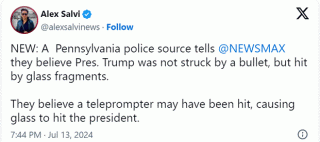FBI
Trump: Release the medical records of the examination of your claimed injury or face the accusations of fraud! – GS https://t.co/bP6146rCvS
trump’s claimed ear injury – GS https://t.co/b7bStdT2D2
Trump enters Republican convention with a bandage covering his right ear… pic.twitter.com/bWIbng95re— Michael Novakhov (@mikenov) July 16, 2024
Day: July 16, 2024
“While the video and photos clearly show blood around his ear, his ear remained completely intact—not even a hole. If a bullet from an “AR-style” weapon had made any contact at all, it likely would have caused a rather visible wound, perhaps even tearing the ear off.”
–
What the…— Michael Novakhov (@mikenov) July 16, 2024
Michael Harrigan, a retired F.B.I. special agent, said the image captured by Doug Mills, a New York Times photographer, seems to show a bullet streaking past former President Donald J. Trump.

An annotated photo showing what appears to be a projectile passing by Donald J. Trump during a rally in Butler, Pa., on Saturday.Credit…Doug Mills/The New York Times
By John Ismay
- Published July 14, 2024Updated July 15, 2024
Follow the latest news on the Trump assassination attempt.
In documenting the Pennsylvania campaign rally on Saturday afternoon that turned into an attempt on a former president’s life, Doug Mills, a veteran New York Times photographer, appeared to capture the image of a bullet streaking past former President Donald J. Trump’s head.
That is the assessment of Michael Harrigan, a retired F.B.I. special agent who spent 22 years in the bureau.
“It absolutely could be showing the displacement of air due to a projectile,” Mr. Harrigan said in an interview on Saturday night after reviewing the high-resolution images that Mr. Mills filed from the rally. “The angle seems a bit low to have passed through his ear, but not impossible if the gunman fired multiple rounds.”
Simple ballistic math showed that capturing a bullet as Mr. Mills likely did in a photo was possible, Mr. Harrigan said.
Mr. Mills was using a Sony digital camera capable of capturing images at up to 30 frames per second. He took these photos with a shutter speed of 1/8,000th of a second — extremely fast by industry standards.
The other factor is the speed of the bullet from the firearm. On Saturday law enforcement authorities recovered an AR-15-type semiautomatic rifle at the scene from a deceased white man they believe was the gunman.
“If the gunman was firing an AR-15-style rifle, the .223-caliber or 5.56-millimeter bullets they use travel at roughly 3,200 feet per second when they leave the weapon’s muzzle,’’ Mr. Harrigan said. “And with a 1/8,000th of a second shutter speed, this would allow the bullet to travel approximately four-tenths of a foot while the shutter is open.”
“Most cameras used to capture images of bullets in flight are using extremely high speed specialty cameras not normally utilized for regular photography, so catching a bullet on a side trajectory as seen in that photo would be a one in a million shot and nearly impossible to catch even if one knew the bullet was coming,” he said.
In Mr. Harrigan’s last assignment, he led the bureau’s firearms training unit and currently works as a consultant in the firearms industry.
“Given the circumstances, if that’s not showing the bullet’s path through the air, I don’t know what else it would be,” he said.
Show it! There is no evidence of it so far.
–
Photographer at rally says bullet took out piece of Trump’s ear https://t.co/T4bzVOxTbB via @YouTube— Michael Novakhov (@mikenov) July 16, 2024
The recent assassination attempt on Donald Trump has reignited discussions about conspiracy theories and the psychology behind them.
Reports indicate that a shooter fired at Trump from about 400 feet away with an AR-style weapon. Fortunately, the attempt failed. Immediately after, the press and Trump himself claimed that he was shot; a bullet pierced his right ear.
One can understand why they initially thought this—there were shots, people were killed, Trump was injured—but it has led to confusion and speculation because, while the video and photos clearly show blood around his ear, his ear remained completely intact—not even a hole. If a bullet from an “AR-style” weapon had made any contact at all, it likely would have caused a rather visible wound, perhaps even tearing the ear off.

But some authorities, such as the Pennsylvania police, are now saying that Trump was hit by glass (perhaps from a shattered teleprompter), rather than a bullet. Whether it be from a teleprompter or something else (I was unable to confirm exactly where they were all located, or whether one was damaged), the hypothesis that Trump was hit by glass, or some other kind of shrapnel, aligns much better with the nature of the wound Trump received.
Yet some are dismissing this as a conspiracy theory, simply because it contradicts the “standard story.” This misunderstands what conspiracy theories are. To explain why, let’s delve into the psychology of conspiratorial thinking, and clarify why the glass /shrapnel hypothesis is more plausible.
The Nature of Conspiracy Theories
Conspiracy theories propose, without evidence, secret plots by powerful groups working behind the scenes. They are often fueled by “proportionality bias,” a cognitive bias that makes us think big events must have big causes and explain complex or traumatic events with grandiose stories that actually have straightforward explanations.
The human brain is also wired to seek patterns and connections, especially in times of uncertainty or fear. This tendency can lead to the endorsement of conspiratorial explanations, which offer a sense of control and understanding. If the attempt on Trump’s life had been successful, it’s likely conspiracy theories would have been even more widespread.
But something else that has fueled conspiracy theories in this instance is the fact that the initial claim that a bullet hit him directly conflicts with the physical evidence. If a bullet from an AR-style weapon had hit him at all, it likely would have torn his ear completely off. But the video and photos taken right after the shoot show his ear to be intact, with not even a hole. This has made some suggest that the whole thing was faked, a hoax, as in the below example:
“A Republican operative, willing to die for the cause, shot random bullets into the crowd; Trump (knowing it was coming) pretended to be shot, ducked down, applied a blood pack, and then remerged for photo ops, knowing there was no real danger.”
Notice that this is a conspiracy; it invokes secret plots by powerful groups working behind the scenes. But the idea that, instead, he was hit by glass or shrapnel from a shot and shattered teleprompter (or something else) is simply an alternative explanation for the wound based on available evidence. Some people are calling this a conspiracy, but by definition, it is not, since it does not involve secret plots or hidden agendas. In fact, it squelches conspiracy theories because it accounts for a piece of evidence—Trump’s intact ear—that is supposedly in favor of the conspiracy theory without appealing to secret plots and powerful groups.
Initial Reporting and Its Flaws
The reason that people are calling the glass/shrapnel hypothesis a conspiracy is because it supposedly contradicts the “official” narrative—that Trump was shot by a bullet—and that is something that conspiracy theories often do: contradict the official narrative. But there actually is no official narrative yet; the investigation into the attack is not complete. All there is right now is initial reporting and personal accounts, both of which psychologists know are notoriously unreliable.
It would be one thing if the investigation was already complete, and it provided the evidence to conclude that Trump actually was struck by a bullet, and people kept insisting that it was only glass—and suggested a giant cover-up was taking place to hide the truth. That would be a conspiracy theory. But right now, we only have initial reports, and initial reports of significant events are often wrong because they are based on incomplete information and hastily gathered eyewitness accounts.
In the chaos and urgency of such moments, details can be misinterpreted, and accurate verification is challenging. Human memory is fallible, especially under stress, leading to errors and inconsistencies. Media outlets, eager to break news quickly, may prioritize speed over accuracy, further contributing to the spread of incorrect initial information.
Trump can certainly be forgiven for thinking, in the heat of the moment, that he was shot; shots were fired, people were injured and killed, and he was wounded. So can all the rest of us. But if, after careful investigation, it is found that this is not the case, one should admit what the evidence reveals. (Of course, if the glass/shrapnel hypothesis is considered, but careful investigation reveals that it is a bullet wound, one should also admit what the evidence reveals.)
The Role of Confirmation Bias
Confirmation bias also plays a crucial role in the persistence of conspiracy theories. People tend to favor information that confirms their preexisting beliefs and dismiss evidence that contradicts them.
For Trump supporters, the narrative of a direct bullet hit may align with a heroic or victimized image of Trump. Conversely, opponents might prefer theories that undermine his claims, such as the idea that he staged the incident.
So, ironically, the glass/shrapnel hypothesis, while it currently appears more plausible, may actually be rejected by both sides because it does not fit neatly into either narrative. The glass/shrapnel hypothesis does not suggest that the whole event was staged—only that there was no near miss, all of the shots fired were off target, and Trump was simply hit by glass/shrapnel caused by one of the shots. Neither does it suggest that Trump miraculously survived direct contact with a bullet. We may like one of these notions better than the other, but as logical thinkers, we must simply follow the evidence where it leads.
The Danger of Mislabeling
Mislabeling rational explanations as conspiracy theories can be dangerous. It fosters a culture of skepticism towards legitimate evidence and encourages the spread of misinformation. By understanding the difference between conspiratorial thinking and logical deduction, we can promote a more rational discourse.
In the Trump incident, acknowledging the glass/shrapnel hypothesis as a plausible explanation can be used to help debunk more far-fetched theories, such as the idea that Trump staged the entire event. These more extreme theories gain traction when initial reports are debunked without a rational alternative being presented.
What the Trump Assassination Attempt Reveals About Conspiracy Theories | Psychology Today https://t.co/YjclqkM6T3
— Michael Novakhov (@mikenov) July 16, 2024
Trump covered up his intact Rightist Ear with Bandage, to look like a war hero! https://t.co/AxF4RPOoIw
— Michael Novakhov (@mikenov) July 16, 2024
–
https://t.co/JxGgAvBBzz
Trump covered up his intact Rightist Ear with Bandage, to look like a war hero! #NewsAndTimes #NT #TNT #News #Times#World #USA #POTUS #DOJ #FBI #CIA #DIA #ODNI#Israel #Mossad #Netanyahu#Ukraine #NewAbwehr #OSINT#Putin #Russia #GRU #Путин, #Россия…— Michael Novakhov (@mikenov) July 16, 2024
–
https://t.co/JxGgAvBBzz
Trump covered up his intact Rightist Ear with Bandage, to look like a war hero! #NewsAndTimes #NT #TNT #News #Times#World #USA #POTUS #DOJ #FBI #CIA #DIA #ODNI#Israel #Mossad #Netanyahu#Ukraine #NewAbwehr #OSINT#Putin #Russia #GRU #Путин, #Россия…— Michael Novakhov (@mikenov) July 16, 2024
The Unsurpassed Master Of Cover-ups!
Trump appears at Republican National Convention with bandage on his ear (GS). His Rightist ear appeared to be perfectly intact on the photos before the convention. https://t.co/jCKekUTd85
See also: https://t.co/OhzRZ1P3Lf pic.twitter.com/AvJvzdPiYW— Michael Novakhov (@mikenov) July 16, 2024

